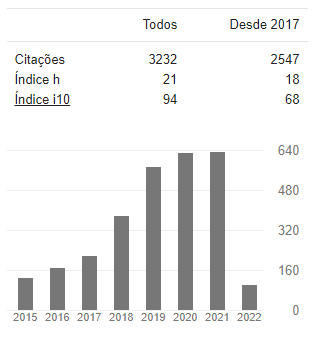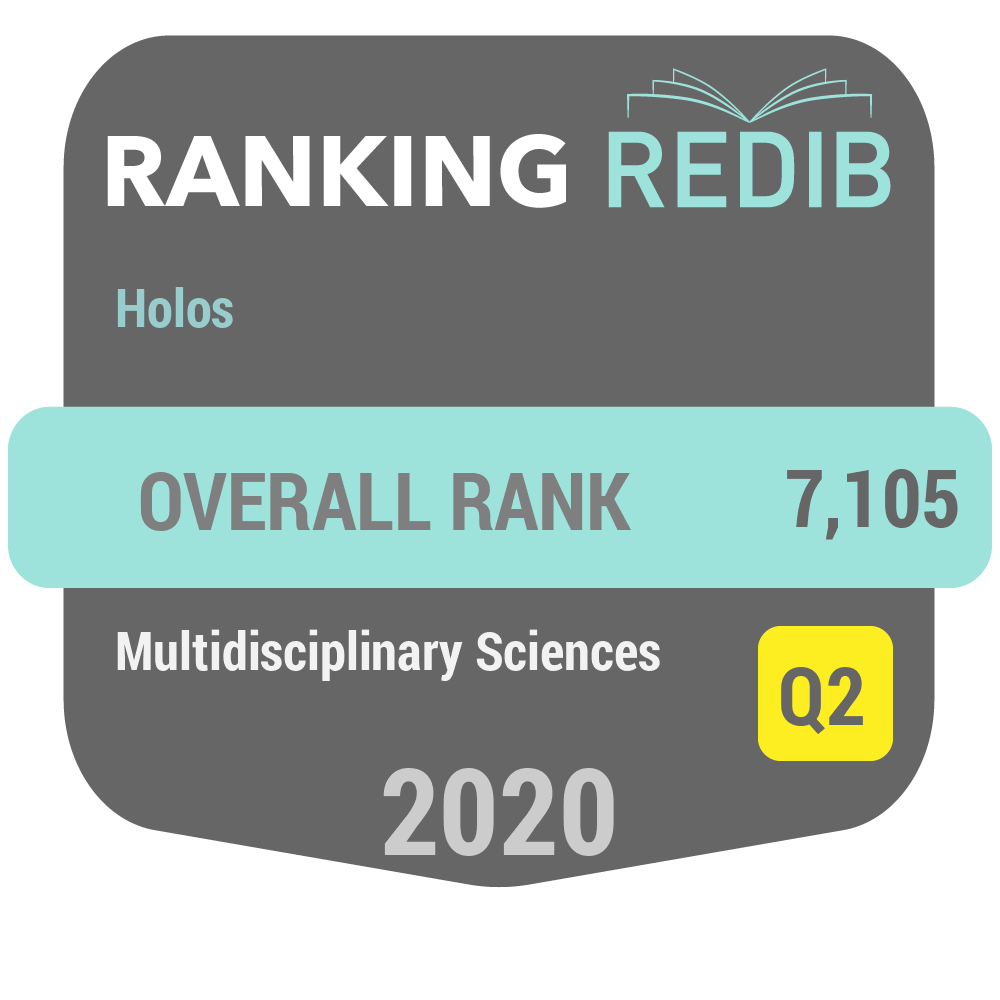BEHAVIOURAL DESCRIPTION OF Sapajus nigritus (GOLDFUSS, 1809) RAISED IN CAPTIVITY AT IPATINGA, MG
DOI:
https://doi.org/10.15628/holos.2014.1671Resumo
The maintenance of animals in captivity is one of the many ways of species preservation and allows studies that are often unattainable under natural conditions. Primate’s behavior and ecology studies supply tools for the development of conservation and management strategies. Consequently, the current research aimed to describe the patterns of behavior of a capuchin monkey, Sapajus nigritus, group raised in captivity at the Biodiversity Center of Associação Esportiva e Recreativa at Ipatinga, MG, Brazil. The Scan Sample was used with five minutes intervals. Ad libitum and Focal Animal were the complementary sampling. Twenty-three behavioral categories were recorded; this is considered average when compared to other ethograms. The behavioral class with greater prominence was foraging, however the different categories of behavior suggest a complex capacity of intra-specific interaction. The information serves as basic tools for the formulation of conservation strategies, management and to the comprehension of ecological interactions.Downloads
Referências
ALBUQUERQUE, V.J., CODENOTTI, T L. Etograma de um grupo de Bugios - pretos Alouatta caraya (Humboldt, 1812) (Primates, Atelidae) em um habitat fragmentado. Revista de Etologia, v. 8, n. 2, p. 97-107, 2006.
ALTMANN, J. Observational study of behavior sampling methods. Behavior, v. 49, p. 227-267, 1974.
BARBOSA, M.N., MOTA, M.T.S. A influência da rotina de manejo na interação social entre pares heterossexuais do sagüi, Callithrix jacchus (Linnaeus, 1758). Revista Brasileira de Zoociências, v. 6, n. 1, p. 29-43, 2004.
BORTOLINI, T.S, BICCA - MARQUES, J.C. A case of spontaneous tool-making by a captive capuchin monkey. Neotropical Primates, v. 14, n. 2, p. 74-76, 2007.
CARRETERO-PIZÓN, X., DEFLER, T.R., FERRARI, S.F. Observation of Black-Capped Capuchins (Cebus apella) feeding on an Owl Monkey (Aotus brumbacki) in the Colombian Llanos. Neotropical Primates, v. 15, n. 2, p. 62-63, 2008.
CARROLL, A. B. The Pyramid of Corporate Social Responsibility: Toward the Moral Management of Organizational Stakeholders. Business Horizons, p. 39-48. 1991.
CURIO, E. Conservation needs ethology. Trends in Ecology and Evolution, v. 11, n. 6, p. 260–263, 1996.
DEFLER, T. R. On the ecology and behavior of Cebus albifrons in eastern Colombia: II – behavior. Primates, v. 20, n. 4, p. 491-502, 1979.
DEL-CLARO, K., TOREZAN-SILINGARDI, H.M. Comportamento animal, interações ecológicas e conservação. In: ROCHA, C.F.D.R., SLUYS, M.V., BERGALLO, H.G. Biologia da Conservação: Essências. Rio de Janeiro: Instituto Biomas. Rima Editora. p. 399-410. 2006.
GIUDICE, A.M., PAVÉ, R. Cebus paraguayanus in Zoos: the spontaneous expression of species-specific behaviors. Neotropical Primates, v. 14, n. 2, p. 65-71. 2007.
GREGORIN, R., SIMÕES, S.A.M., LIMA, I.J., SILVA JUNIOR, J.S. Ordem Primates. In: REIS, N. R., PERACCHI, A.L., FREGONEZI, M.N., ROSSANEIS, B.K. Mamíferos do Brasil: Guia de Identificação. Rio de Janeiro. p. 101-211. 2010.
IPATINGA. 2008. Disponível em: <http://www.ipatinga.mg.gov.br/>. Acesso em: 25 nov 2008.
IZAWA, K., MIZUNO, A. Palm-fruit cracking behavior of wild black-capped capuchin (Cebus apella). Primates, v. 18, n. 4, p. 773-792, 1977.
JALLES-FILHO, E., CUNHA, R.G.T., SALM, R.A. Behavioral flexibility and tool selection in a tufted capuchin monkey (Cebus apella). Neotropical Primates, v. 14, n. 3, p. 112-115, 2007.
KIERULFF, M.C.M., MENDES, S.L., RYLANDS, A.B. Cebus nigritus. IUCN Red List of Threatened Species. 2008. Disponível em: . Acesso em: 04 abr 2013.
LYNCH, J.W., RÍMOLI, J. Demography of a group of tufted capuchin monkeys (Cebus apella nigritus) at Estação Biológica de Caratinga, Minas Gerais, Brazil. Neotropical Primates, v. 8, n. 1, p. 44-49, 2000.
LYNCH ALFARO, J.W., SILVA JR., J.S., RYLANDS, A.B. How different are robust and gracile capuchin monkeys? An argument for the use of Sapajus and Cebus. American Journal of Primatology. v. 74, p. 273-286, 2012.
LUDWIG, G., AGUIAR, L.M., ROCHA, V.J. Uma avaliação da dieta, da área de vida e das estimativas populacionais de Cebus nigritus (Goldfuss, 1809) em um fragmento florestal no norte do Paraná. Neotropical Primates, v. 13, n. 3, p. 12-18, 2005.
MARTIN, P., BATESON, P. Measuring Behaviour: An Introductory Guide. 2ed. Cambridge University Press, 1993, 222 p.
MYERS, N., MITTERMEIER, R.A., MITTERMEIER, C.G., FONSECA, G.A.B., KENT, J. Biodiversity hotspots for conservation priorities. Nature, v. 403, p. 853-858, 2000.
OTTONI, E.B., IZAR, P. Capuchin monkey tool use: Overview and implications. Evolutionary Anthropology, v. 17, p. 171-178, 2008.
PATERSON, J. D. Primate behavior: an exercise work book. Waveland Press, Inc., Illinois, USA. 1992. 105 p.
PERÔNICO, C. Descrição e correlação de fácies sedimentares de testemunhos recuperados em lagos assoreados na região do médio rio Doce, Minas Gerais, sudeste do Brasil. Natureza online. 2009. Disponível em: <http://www.naturezaonline.com.br>. Acesso em 25 ago 2011.
PERRY, S. Social traditions and social learning in capuchin monkeys (Cebus). Philosophical Transactions of Royal Society. v. 366, p. 988–996, 2011.
PINHA, P. S. Interações sociais em grupos de macacos prego (Cebus libidinosus) no Parque Nacional de Brasília. Brasília. 2007. Dissertação de Mestrado em Ecologia - . Universidade de Brasília. 2007.
REIS, N.R., PERRACHI, A.L., PEDRO, W.A., LIMA, I.P. Mamíferos do Brasil. Londrina. 2006. 437 p.
REIS, N.R., PERRACHI, A.L., PEDRO, W.A., LIMA, I.P. Mamíferos do Brasil. 2 ed. Londrina. 2011. 439 p.
RESENDE, B.D., OTTONI E.B. Brincadeira e aprendizagem do uso de ferramentas em macacos-prego (Cebus apella). Estudos de psicologia, v. 7, n. 1, p. 173-180, 2002.
RESENDE, B.D., GRECO, V.L.G., OTTONI, E.B., IZAR, P. Some observations on the predation of small mammals by tufted capuchin monkeys (Cebus apella). Neotropical Primates, v. 11, n. 2, p. 103-104, 2003.
ROCHA, V.J. Macaco prego, como controlar esta nova praga florestal? Floresta, v. 30, p. 95-99, 2000.
SERBENA, A.L., MONTEIRO-FILHO, E.L.A. A Behavioral Description of Captive Young Capuchin Monkey (Cebus apella). Revista de Etologia, v. 4, n. 2, p. 109 -116, 2002.
STRIER, K.B. The behavior and ecology of wooly spider monkeys, or muriquis (Brachyteles arachnoides). Tesis (Doutorado) - Harvard University, Cambridge. 1986.
VELOSO, H.P., RANGEL FILHO, A.L.R., LIMA, J.C.A. Classificação da vegetação brasileira, adaptada a um sistema universal. Rio de Janeiro: Instituto Brasileiro de Geografia e Estatística. 1991. 124 p.









































